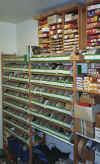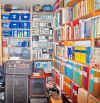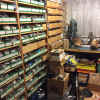|
The 20th Century, the broadcast years and then back to the roots
We have now
passed the turn of the millennium, and I have had a relapse into disco
installation that I was doing somewhat in the late 1960s.
On Gothenburg’s night club street Avenyn, I built for some restaurant
owners some discotheques, live stages and karaoke bars complete with
sound, light and smoke.
It was interesting to do this in modern times with high tech sound and
lighting equipments, where I used for example Rodec, FormulaSound,
Soundcraft, Denon, Urei, Lab JBL and Meyer sound system.
And of course all moving light effects from the larger quality
manufacturers.
In addition
to this detour in the entertainment industry, there was a lot more work
with broadcast equipment and installation, but there were also some new
recording studios that I am involved in as consultant and installer.
Another odd but interesting projekt I did was to build two Amek Angela
24 input mixing console together to one 48 inputs console.
This was a huge job, as both frames were emptied of their contents, i.e.
motherboard cables, patch bays, connectors and everything.
The frames were then spliced together mechanically, the motherboards
were sawn into smaller sections so that we could make our own placement
of the different types of modules, a new ground system with copper bar
from end to end in the frame and also a new voltage rails distribution
system was made.
Completely new cabling between the motherboard to the extended patchbay
section and then to the Edac connectors was done with 1,000 meters of
new balanced installation cable
All modules were rebuilt in many ways, for example to get important
inputs and outputs balanced, and of course renovated and re-capped.
In addition, the console was equipped with a new power supply, connector
panel VU-bridge, woodwork and arm pad.
To be able to hear this enormously wide-ranging work, I had the help of
my friend Ljupce Mitrowski, who is very good and careful with cabling
and soldering.
I now also
got an idea to import Chinese-made copies of large-membrane condenser
microphones, where manufacturing at this time had begun to spread in
China.
My idea was to find a small factory that made a microphone with a nice
and mechanically good and stable housing, and take out the contents and
then build in my own electronics.
After buying samples from four manufacturers, I decided one microphone
from a small factory in the Goandgong area in the southern coast of
China, unlike the others who were in Shanghai.
This was a large-diaphragm cardioid microphone with a body that had a
sturdy molded inner frame and outer casing joined by a threaded ring at
the bottom.
The only downside was that it looked like a Shure KSM32, but
unfortunately there was nothing to be done about this.
I ordered 50 pieces with the name Hansén Audio HCM-101, including
elastic suspension and case.
It turned out that this one-sided cardioid 1 inch capsule was very good,
so I kept it, but the rest of the electronics was rebuilt for the most
part.
Modified JFET capsule front end amp, and also a newly designed driver
amp for the output transformer, as well as an added voltage regulator.
The result was very good, and the HCM-101 received good marks in some
Swedish music magazines, where it was compared with the Neuman TLM-103,
among others.
All the 50 copies were quickly sold, but I never made any more of these,
as in the years just after that a lot of China microphones came out on
the maknad with made up names, so after this my interest in continuing
to rebuild China microphones with my name stopped.
In the middle
of the 2000s, I started to get tired of the recording industry, there
were too many digital home studios and almost no real suitable studios
left here in Gothenburg and the surrounding area, and I refused to
repair digital audio interfaces and outboard equipments with
surface-mounted components.
I decided to resume the source of income I had in the 1960s/70s which
was repairing guitar amplifiers and other musician's equipment.
I have calculated that between 2004 and until my retirement, there were
about 4,000 guitar and bass amplifiers that have been on my workbench.
I also continued to repair and renovate studio microphones of all ages
brands and types, which throughout my years has been a great interest of
mine.
|












